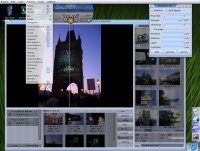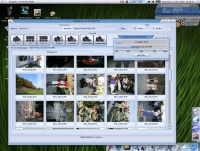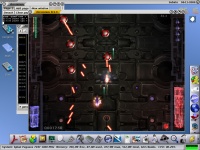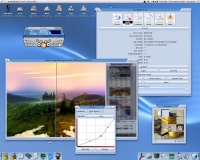Applications dédiées
From MorphOS Library
La taille réduite de l'OS et sa structure simple (en termes relatifs) impliquent, entre autres, que beaucoup de projets exigeant une équipe de programmeurs sur d'autres plateformes deviennent souvent des projets individuels modestes dans les environnements MorphOS/Amiga. Cela ralentit le développement, mais donne également une excellente efficacité, simplicité et compacité au code. Dans cette section, nous mentionnons quelques excellents outils pour MorphOS, alors que dans la prochaine section vous trouverez des descriptions pour les applications les plus importantes et les plus puissantes.
AmiNetRadio
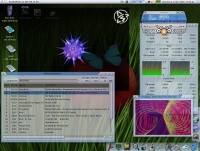
One thing worth mentioning is that ANR is actually an AmigaOS 3.x executable coded for Motorola's 680x0 range of CPUs. Emulation transparency and effectiveness in MorphOS are so good that most of the aforementioned players are compiled exclusively for MorphOS in native PowerPC code, and can be mixed without any need for the user to be careful. The same can be said for the video plugins: ANR is compatible with the API of AmiAMP (an old Amiga version of the well known WinAMP), and therefore it is possible to mix 68k and PowerPC plugins. A fact even more interesting is that it is possible to use plugins compiled for the old executable formats (PowerUp and WarpUp) introduced years ago for PowerPC accelerators on classic Amigas. Non-Amiga people should not worry: all that matters to them is that MorphOS is transparently compatible with all the weird kinds of executables the Amiga community has introduced in the past, as long as they were coded in a "system-friendly" manner. ANR itself makes use of some extensions of the AmigaOS 3.x APIs for better skinning capabilities, thus resulting a MorphOS program at all effects, while consisting of 68k code.
ShowGirls
As the name says (and if for you it doesn't, it just means you are not geek enough), this is an image viewer. While the internal viewer of Ambient provides the required basic functions, ShowGirls does a lot more: its interface is usually divided in two parts, on one side there are the thumbnails (with support of the Exif format in JPEG pictures, which means that it doesn't need to load a 3MB+ image just to show a 50×50 preview) and on the other side the selected image is displayed. The image can be viewed in full screen as well, can be zoomed in and out, and can be elaborated. ShowGirls in fact features some basic image manipulation tools for adjusting colours, changing image resolution, as well as smoothing and sharpening operators, noise reduction, glow and blur effects, and enables cropping, rotating, flipping, as well as batch conversions. It is possible to use also a 3D view (with 3D accelerated rendering), but that's mostly a nice toy option.The program was originally born as a tool for digital cameras, and in fact it can perform all the needed operations on files on a mass storage device. And in conjunction with a USB camera working as mass storage device you will rarely need anything else. If your camera supports the PTP standard, though, you might need to look elsewhere.
Starting from the 2.0 release of MorphOS, ShowGirls is provided with the OS itself as a contribution to be found in the Application directory, but additional updates are still available separately in the programmer's site.
PTPDigCam
This is a nice native and original software (not based on libraries ported from Linux) that enables to download and delete pictures, videos and audio files from Canon, Nikon, Kodak, Sony cameras supporting the PTP standard. The latest versions let the user choose the images from their Exif thumbnail as well, and the program is well written, with a nice and polished MUI interface. It is not the most complex program in the world, but it shows the spirit of the old Amiga community: most alternative OSs do not support the PTP standard and require the users to buy a card reader. As inexpensive as this add-on might be, it is always better to have a software supporting even this not so widely recognised standard. There is also an alternative, called SimpleCam and based on libPTP ported from the Linux environment, but with a MUI GUI. And for those who like to control remotely their digicam, there is also CanonToolBox, based on libPTP, too.With the release of MorphOS 2.0, the USB stack Poseidon directly supports the PTP standard. It is therefore possible to access the contents of any digicam internal memory just like it was a mass storage USB device. Obviously, since Ambient supports image thumbnails, it is possible to have a scaled preview of the pictures to be downloaded. It is still possible to use a third party program like PTPDigCam: the user just needs to unbind the device in the USB preferences, easily accessible from the System Preferences panel.
PowerSDL
This evocative name labels a software package, whose port allows to broaden, indirectly, the availability of software on MorphOS. Simple DirectMedia Layer (SDL) is a cross-platform multimedia library that provides an abstraction layer for graphics, sound, and input APIs over various platforms. SDL allows a developer to write computer games or multimedia applications that run on many operating systems, and makes a lot of ports possible. The MorphOS version has been greatly improved upon the original Amiga port, and it is now constituted by a number of shared libraries (which, incidentally, make possible to use them in closed source/non GPLed software) making full use of the MorphOS APIs.Frying Pan
While many AmigaOS applications can still be run on MorphOS, including the popular CD-writer software MakeCD, Commodore's demise preceded the introduction of DVDs. Thus Frying Pan, a CD / DVD burning and mastering software, is filling this gap meanwhile. The application is shareware and available natively for MorphOS.OS4Emu
This is an example of a software that broadens the working applications directly: it is a wrapper for the AmigaOS 4 APIs (which is very similar to the MorphOS one, given the common heritage) to the correspondent MorphOS functions. This means that by double clicking on the icon of an AmigaOS 4 executable (or typing its name in a CLI window) there is a good chance it will work. Notable examples include FPSE, the Sony PlayStation emulator, that ironically, thanks to Poseidon (the USB stack included in MorphOS), even supports USB joypads. (This is enabled by a simple feature in Poseidon, that associates keystrokes selected by the user to joypad buttons). Other working titles are SID4Amiga (a player for C64 music files), some scene demos, many shell commands and utilities, and much more. The compatibility is not total, but it is improving at every new release.
